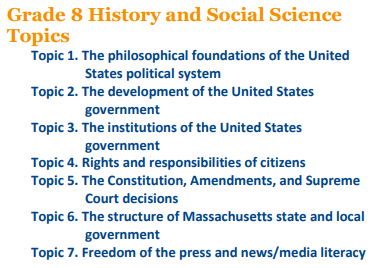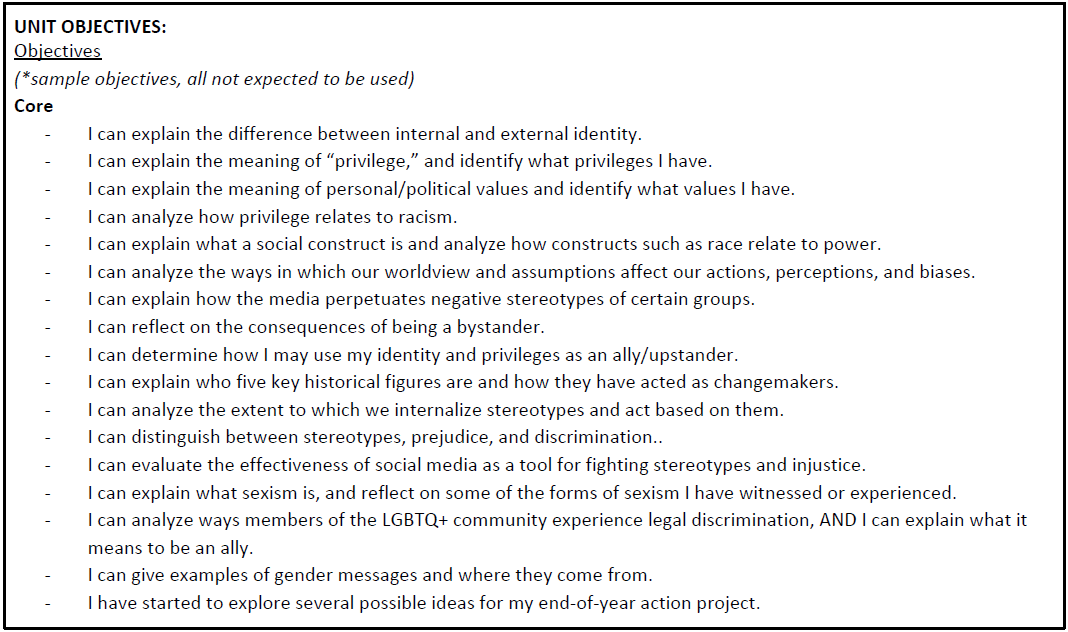Democratic Knowledge Project
For the 2019-2020 school year the town of North Andover launched a pilot civics program in anticipation of the requirement that the 2020-1021 8th grade history curriculum would be civics.
The curriculum chosen by our didstrict was the Democratic Knowledge Project.
The Democratic Knowledgte Project (DKP), 8th grade civics program was created as a
collaboration between the DKP and the Cambridge MA school district. The details of this selection were discussed in an interview with civics teacher Mr. McGraver on
Youth Center director Rick Gorman's podcast.
Right from the start the differences between the topics to be covered in the DESE Framework
(page 104) and the Units in the DKP's curriculum are stark. Below are the topics outlined in the DESE framework.

These are the units covered in the DKP.

Are the DESE topics and the DKP units equal? Consider that every DKP Unit has as a charge a "changemaker role" for the unit. These students have no basis in why
we have the laws that we do, nor are we teaching those foundational lessons. Rather we are challenging them to be "changemakers," without context for the foundational
laws of out nation and why they exist. The pilot of the DKP civics program was billed as "Civics in Action." This is what as known as "Action Civics." Action Civics
dimishes learning over promoting activism. There is, of course, nothing wrong with promoting civic activiwm. The member of this group are, afterall, civic activists.
The problem we have is that the first time students are exposed to civics should be to build a foundational knowledge of the historical context of the governing laws of
our nation, rather than immediately challenging students to become "changemakers" within a highly biased framework.
The following are the objectives listed for the first unit in the DKP curriculum.

For the current school year parents were told that the teachers would be meeting over the summer to develop a new consolidated curriculum to be used across all teams.
While the DKP would still be used, it would just be one of many resources available to teachers in creating this curriculum. However, all of the units of discussion
in the current year curriculum are the same as 2021-2022, and many of the same lessons are presented. This includes the concept of the Iroquois influence on the US Constitution.
One thing that has changed is that Mr. McGravey’s emails home to parents have become less frequent and they are less detailed than they were last year.
In justifying the use of the DKP in the NAMS Civics program the district relies on this chart:

The source can be found here: Highlighted Core Materials
One of the primary metrics used is "Culturally Responsive Pedagogy", in the FAQ
Race,
Racism, and Culturally Responsive Teaching in History and Social Science in Massachusetts
DESE begins the section on "Culturally Resopnsive Pedagogy" with "As defined by scholar Gloria Ladson-Billings in her seminal article “Toward a Theory of Culturally Relevant Pedagogy
Toward a Theory of Culturally Relevant Pedagogy
” (1995), culturally responsive teaching is teaching that promotes..."
Gloria Ladson-Billings is also the founder of Critical Race Theorist, and published her paper "
Toward a Critical Race Theory in Education" also in the Fall of 1995 in a separate publication, in which she makse statements such as:
-
"Marxist and Neo-Marxist formulations about class continue to merit consideration as theoretical models for understanding social inequity"
- "Many discussions of democracy conflate it with capitalism despite the fact that it is possible to have a democratic government with an economic system
other than capitalism...Traditional civil rights approaches to solving inequality have depended on the “rightness” of democracy while ignoring the
structural inequality of capitalism.”
- "“Posession – the act necessary to lay the basis for rights in property-was defined to include only the cultural practices of Whites.
This definition laid the foundation for the idea that whiteness-that which whites alone possess-is valuable and is property.”